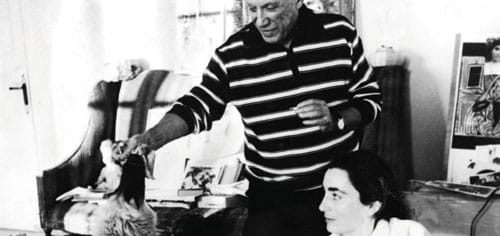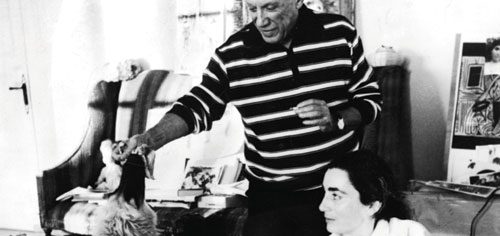

Picasso’s Dogs
Muse and mascot: the artist’s life-long love affair with his canine companions
Pablo Picasso was born in Málaga, Spain, and
was the son of a Basque drawing teacher
named Blasco Ruiz and an Italian mother,
Maria Picasso. According to Spanish naming
traditions, his name was Pablo Picasso y Ruiz,
and so he signed his earliest pictures. Before he died at the
age of 91, he would sign over 45,000 works.
One professor of fine arts told me that Picasso had five
passions: “his art, his ego, his image, his women, and his
dogs, in that order.”
In fact, Picasso’s life was full of dogs. He had many,
of many different breeds, including terriers, Poodles, a
Boxer, Dachshunds, a German Shepherd, Afghan Hounds,
and numerous “random bred” dogs. Many of these were
“borrowed” or “stolen” from friends and associates in the
same way that many of his women were. The dogs were
as much a part of his life as his female companions, and
they went everywhere with him. He also gave dogs to his
friends as gifts, in part to ensure that he would never be in
their company without a dog. When his various relationships
broke up, Picasso would often leave all of his goods
behind him and go off to live in a new place with a new
woman. Usually, he would only arrange to have a few
things returned to him, including some of his recent paintings,
some of his brushes and paint, and his dog or dogs.
The rest was all left to friends or to the woman whom he
was leaving.
One of the most important of Picasso’s “stolen” dogs
came from David Douglas Duncan, a photographer for Life
magazine. Picasso liked Duncan and, for nine months, the
photographer was drawn into the world of La Californie,
Picasso’s villa near Cannes. He was given carte blanche to
photograph whatever and whomever he liked.
When Duncan came to visit he brought along one of
his own dogs, a Dachshund named Lump. The dog took a
liking to Picasso, and the feeling was mutual. “He jumped
ship,” remembers Duncan. “He was a very engaging dog,
and as soon as he arrived at Picasso’s house he decided
this was heaven and this was where he was going to
stay.” Picasso played with the dog, gave him bits from his
breakfast, and sat Lump on his lap to caress him while
talking and being photographed by Duncan. When Duncan
was about to leave, Picasso held Lump and said to Duncan
something like, “You will leave him, of course?”
In his book on Picasso and Lump, Duncan suggests
that, although he was fond of the dog, Lump was getting
along badly with a larger dog that he owned. In addition,
his nomadic lifestyle made travelling with the small dog
difficult. Actually, the likelihood is that Duncan, like most
other people who interacted with Picasso, simply found it
difficult to refuse any request that the artist made, whether
for money, services, or the companionship of women or
canines.
Picasso’s dogs often worked their way into his art. One
of his first pieces was a paper cutout of a boyhood terrier.
Lump was drawn into several of Picasso’s interpretations
of Velásquez’s painting Las Meninas. The artist replaced
the massive hound in the foreground of the original with
abstract renderings of Lump. Freaky, a mixed-breed, is
the subject of many drawings as well, while Kabul, his Afghan Hound, appears in several paintings with one of his wives,
Jacqueline.
I got to meet Picasso once. The occasion was a reception held
in honor of the unveiling of a large piece of public sculpture that
was commissioned by a New York University. The reception was
one of those large formal affairs. I no longer remember why I was
invited; however, I was there with a few other academics, mostly
from fine arts departments.
Picasso was already well into his eighties. I remember being
surprised by how small and wiry he looked. What I remember
most were his eyes—they were enormous in relation to his head
and, at first glance, they seemed almost black in color. He was
surrounded by a number of dignitaries who were controlling the
flow of people who wanted to meet him.
One of my colleagues leaned over to me and said “We can
go up and try to say hello, but he really only talks to important
people or people who can do something for him.”
“Well, I’d like to try,” I said, “I wanted to ask him a question.”
I had recently read that, despite the fact that he had lived in
France for around 50 years, Picasso remained very proud of his
Spanish heritage and since I spoke that language reasonably well I
hoped that might gain me a moment of his time.
Once I was in front of him, I quickly asked him in Spanish
“Excuse me. I know that this occasion has to do with your art, but
might I ask you a quick question about your dogs?”
On hearing his native tongue being spoken, he looked directly
at me with the barest hint of a smile.
“Certainly,” he said.
“I have seen photographs of you with so many different breeds
of dogs. Is there any one breed, or any one dog, that was your
favourite?”
Now he did smile.
“I have had so many,” he said and as he started speaking
his dark eyes drifted upward, “Some were gifts, some I found.
Breeds… I do not usually get the same breed of dog again. I want
each to be an individual and I do not want to live with the ghosts
of the other dogs. Of course there was Lump, my Dachshund. I
used to put him in my paintings when they needed something to
make them lighter and more amusing. I suppose that I am fickle
in my affections, but after a dog has left my life I try to quickly fill
its place with another. Right now I have an Afghan Hound named
Kabul. He is elegant, with graceful proportions, and I love the way
he moves. I put a representation of his head on a statue that I created
for Daley Plaza in Chicago and I do think of him sometimes
while I am in my studio.”
He looked directly at me, and as he continued speaking, his
right hand was making lines and curves in the air, as if he were
drawing something on an invisible canvas in front of us.
“Often, if he comes into my mind when I am working, it alters
what I do. The nose on the face I am drawing gets longer and
sharper. The hair of the woman I am sketching gets longer and
fluffy, resting against her cheeks like his ears rest against his head.
Yes, if I have a favourite, for now at least, it is my Afghan Hound,
Kabul.”
He smiled at me in a way that told me that my audience was
over.
Since that meeting, I have looked at Picasso’s art in a different
way. Now, I always look at the noses and hair and wonder if the
picture I am looking at has a bit of Afghan Hound in it.
Join the newsletter and never miss out on dog content again!
"*" indicates required fields
By clicking the arrow, you agree to our web Terms of Use and Privacy & Cookie Policy. Easy unsubscribe links are provided in every email.